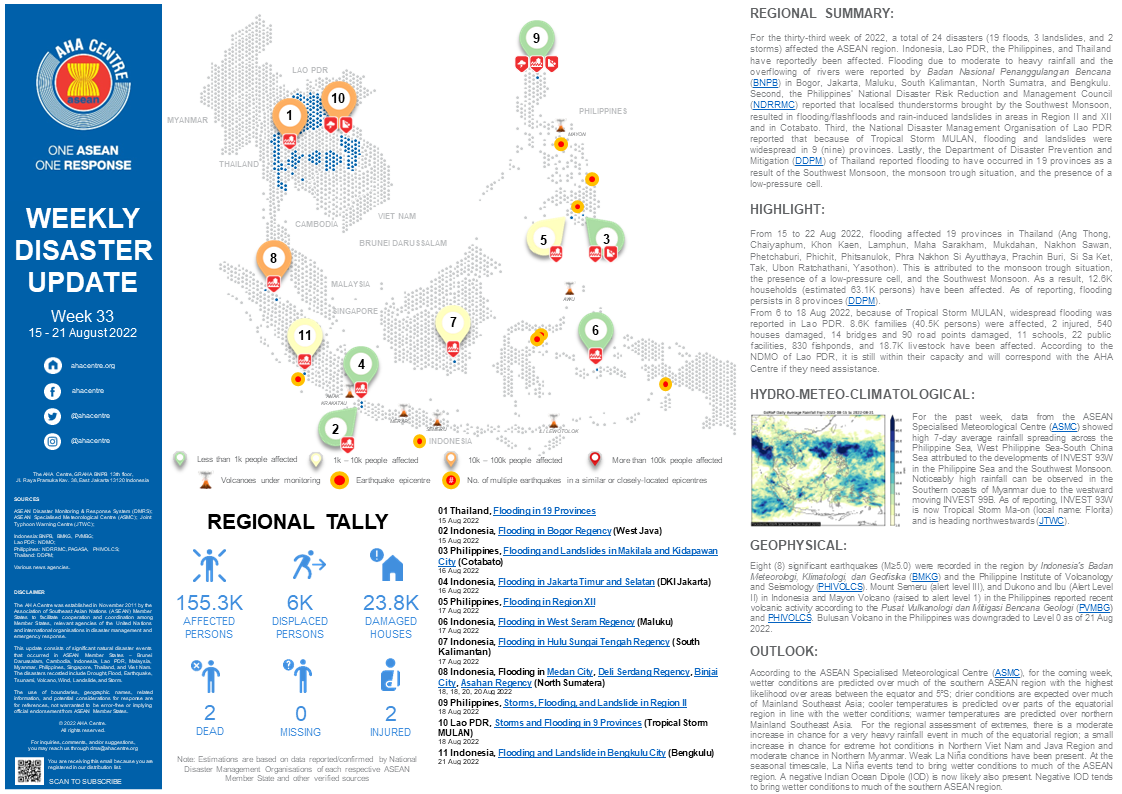
REGIONAL SUMMARY:
For the thirty-third week of 2022, a total of 24 disasters (19 floods, 3 landslides, and 2 storms) affected the ASEAN region. Indonesia, Lao PDR, the Philippines, and Thailand have reportedly been affected. Flooding due to moderate to heavy rainfall and the overflowing of rivers were reported by Badan Nasional Penanggulangan Bencana (BNPB) in Bogor, Jakarta, Maluku, South Kalimantan, North Sumatra, and Bengkulu. Second, the Philippines’ National Disaster Risk Reduction and Management Council (NDRRMC) reported that localised thunderstorms brought by the Southwest Monsoon, resulted in flooding/flashfloods and rain-induced landslides in areas in Region II and XII and in Cotabato. Third, the National Disaster Management Organisation of Lao PDR reported that because of Tropical Storm MULAN, flooding and landslides were widespread in 9 (nine) provinces. Lastly, the Department of Disaster Prevention and Mitigation (DDPM) of Thailand reported flooding to have occurred in 19 provinces as a result of the Southwest Monsoon, the monsoon trough situation, and the presence of a low-pressure cell.
HIGHLIGHT:
From 15 to 22 Aug 2022, flooding affected 19 provinces in Thailand (Ang Thong, Chaiyaphum, Khon Kaen, Lamphun, Maha Sarakham, Mukdahan, Nakhon Sawan, Phetchaburi, Phichit, Phitsanulok, Phra Nakhon Si Ayutthaya, Prachin Buri, Si Sa Ket, Tak, Ubon Ratchathani, Yasothon). This is attributed to the monsoon trough situation, the presence of a low-pressure cell, and the Southwest Monsoon. As a result, 12.6K households (estimated 63.1K persons) have been affected. As of reporting, flooding persists in 8 provinces (DDPM).
From 6 to 18 Aug 2022, because of Tropical Storm MULAN, widespread flooding was reported in Lao PDR. 8.6K families (40.5K persons) were affected, 2 injured, 540 houses damaged, 14 bridges and 90 road points damaged, 11 schools, 22 public facilities, 830 fishponds, and 18.7K livestock have been affected. According to the NDMO of Lao PDR, it is still within their capacity and will correspond with the AHA Centre if they need assistance.
HYDRO-METEO-CLIMATOLOGICAL:
For the past week, data from the ASEAN Specialised Meteorological Centre (ASMC) showed high 7-day average rainfall spreading across the Philippine Sea, West Philippine Sea-South China Sea attributed to the developments of INVEST 93W in the Philippine Sea and the Southwest Monsoon. Noticeably high rainfall can be observed in the Southern coasts of Myanmar due to the westward moving INVEST 99B. As of reporting, INVEST 93W is now Tropical Storm Ma-on (local name: Florita) and is heading northwestwards (JTWC).
GEOPHYSICAL:
Eight (8) significant earthquakes (M>5.0) were recorded in the region by Indonesia’s Badan Meteorologi, Klimatologi, dan Geofisika (BMKG) and the Philippine Institute of Volcanology and Seismology (PHIVOLCS). Mount Semeru (alert level III), and Dukono and Ibu (Alert Level II) in Indonesia and Mayon Volcano (raised to alert level 1) in the Philippines reported recent volcanic activity according to the Pusat Vulkanologi dan Mitigasi Bencana Geologi (PVMBG) and PHIVOLCS. Bulusan Volcano in the Philippines was downgraded to Level 0 as of 21 Aug 2022.
OUTLOOK:
According to the ASEAN Specialised Meteorological Centre (ASMC), for the coming week, wetter conditions are predicted over much of the southern ASEAN region with the highest likelihood over areas between the equator and 5°S; drier conditions are expected over much of Mainland Southeast Asia; cooler temperatures is predicted over parts of the equatorial region in line with the wetter conditions; warmer temperatures are predicted over northern Mainland Southeast Asia. For the regional assessment of extremes, there is a moderate increase in chance for a very heavy rainfall event in much of the equatorial region; a small increase in chance for extreme hot conditions in Northern Viet Nam and Java Region and moderate chance in Northern Myanmar. Weak La Niña conditions have been present. At the seasonal timescale, La Niña events tend to bring wetter conditions to much of the ASEAN region. A negative Indian Ocean Dipole (IOD) is now likely also present. Negative IOD tends to bring wetter conditions to much of the southern ASEAN region.
Sources:
ASEAN Disaster Monitoring & Response System (DMRS); ASEAN Specialised Meteorological Centre (ASMC); Joint Typhoon Warning Centre (JTWC);
Indonesia: BNPB, BMKG, PVMBG;
Lao PDR: NDMO;
Philippines: NDRRMC, PAGASA, PHIVOLCS, DSWD;
Thailand: DDPM;
Various news agencies.







